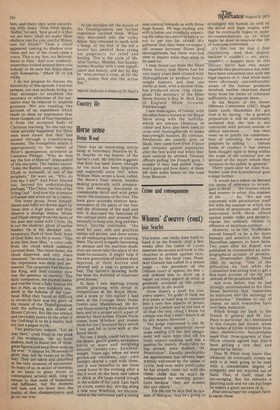Country life
Horse sense
Denis Wood
There was an interesting article lately in Veterinary Practice by R. H. Smythe on the history of the farrier's craft. Mr Smythe suggests that little has been learnt (though far too much has been forgotten and neglected) since 1847, when William Miles wrote a book called, The Horse's Foot, .which, besides dealing practically with preparation and shoeing, discussed in considerable detail and with great clarity the anatomy of the foot. The book gave accurate relative measurements of the parts of the foot and the thickness of the wall and sole. It discussed the functions of the various parts and stressed the necessity to keep sole, frog and bars intact. Smythe concludes, "the need for sane, safe and practical smiths will persist, and there exists no all-embracing means of training them. The anvil is rapidly becoming an antique and the machine-made shoe can never take the place of the made-to-measure. It might help if the new generation of farriers were deprived of their knives and allowed only a rasp to prepare a foot. The farrier's drawing knife has been the downfall of countless good horses."
In June I saw aspiring young smiths gleaming with sweat in competitions at the Royal Show, and a week or two earlier I had seen, at the Courage Shire Horse' Centre near Maidenhead, Mr Ernest Poole making from plain metal bars, and on a proper anvil, a pair of shoes for Shire horses. Ernest Poole comes from Windsor and makes shoes for the Cleveland Bays which I saw and fell in dove with at the Royal Show. No one, I think, could fail to love the Shires, gentle giants, seventeen hands or more and weighing around twenty-two hundredweight. Years ago, when we were grown-up children, our own hunters shared a yard with them, and it was beautiful to see them come home in the evening after a day's work on the farm and taken to drink at the large round trough in the middle of the yard. Last April on a cold, sunny day, driving along a lane near Bradfield, we encountered at the narrowest part a young man coming towards us with three huge horses. He was leading one with a halter and trustfully expecting the other two either to follow or not to get too far ahead. We gathered that they were two-year-old crosses between Shires and thoroughbreds, but there was not time to inquire what they were to be used for.
I soon found out from the Shire Horse Society that Shires had for very many years been crossed with thoroughbreds to produce heavyweight hunters, and that one owner at least, with a second cross, has produced show ring champions. The secretary of the Shire Horse Society is Roy W. Bird, East of England Show Ground, Peterborough.
I saw them again, of course, with the other heavy horses at the Royal Show along with the Suffolks, which are always chestnut in colour and have also been used to cross with thoroughbreds to make heavyweight hunters. By contrast, Percherons are usually grey or black; they came here from France and certainly gained popularity after the first world war when they were noticed by shrewd Yeomen officers pulling the French guns. I wonder if they had pulled Napoleon's guns and how many of them left their noble bones on the road from Moscow.


































 Previous page
Previous page